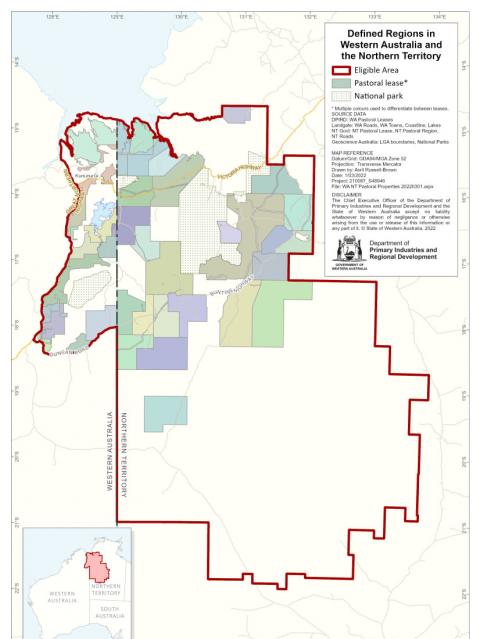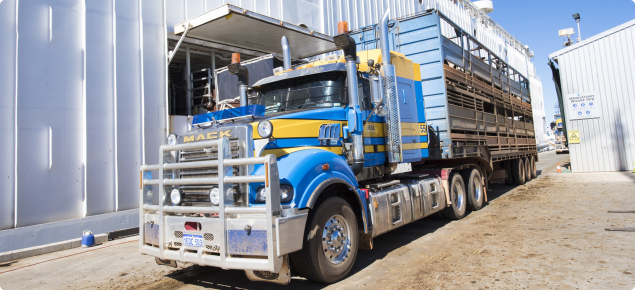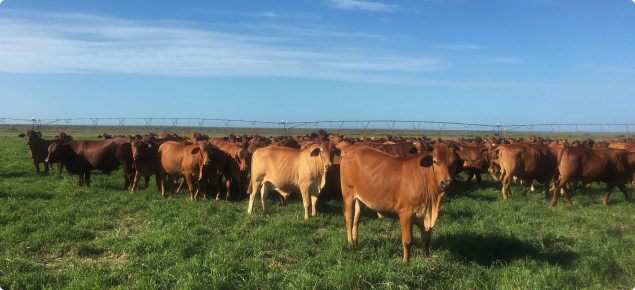Livestock imported from the Northern Territory (NT) into Western Australia (WA) undergo an inspection at the Department of Primary Industry and Regional Development’s (DPIRD) inspection point at Kununurra to ensure they meet WA’s import conditions. These import conditions help protect WA from pests and diseases that are not present in the state.
Cattle imported into WA may present a risk of introducing seeds of weeds which may have significant environmental and economic impacts. To mitigate this risk, cattle are inspected for burrs and seeds at the inspection point and the truck transporting the cattle is washed down before undertaking further movement in the state.
The distances travelled when importing cattle from the NT into the Kimberley can be long and the requirement to present cattle for inspection at Kununurra can add travel distance to the journey. In certain circumstances where eligibility criteria are met, DPIRD may approve importation of cattle from defined areas in the NT to defined areas in WA without an inspection at the Kununurra Inspection Point.
Following an assessment of an application provided by the WA party, DPIRD issues, for those approved, an import permit (or inspector’s direction notice for cattle transiting WA when moving from a property in the NT defined region to a property in the NT defined region requires crossing the WA border) to authorise these movements.
Criteria for application for exemption of imported cattle inspection at Kununurra: properties in defined NT and WA regions
Cattle intended for importation from properties in defined regions in the NT to properties in defined regions of WA are eligible for an application to DPIRD for an exemption from presentation to the Kununurra inspection point, as these two regions are considered to have a similar weed risk profile.
This section details the criteria that need to be met for an application to be assessed by DPIRD, noting that the cattle must meet all published import requirements. Following an assessment of an application provided by a WA party, DPIRD issues, for those approved, an import permit (or inspector’s direction notice for cattle transiting WA as detailed in point 3) in order to authorise these movements.
Defined regions in the NT are properties in the Victoria River District and Tanami Desert.
Defined regions in WA are properties east of the Great Northern Highway and north of the Duncan Road in the shires of Halls Creek and Wyndham/East Kimberley (and properties intersected by these roads).
1. Cattle from properties in the defined region of the NT moved to properties in defined regions of WA.
- Cattle must have been born and resided on an approved property in the NT defined region.
- Eligibility for this direct movement applies only to importation of cattle owned and managed by the WA consignee property and must not be used for cattle owned and managed by third parties in WA.
2. Cattle from properties in the defined region of NT moved to WA for immediate export via Wyndham or to a Department of Agriculture, Fisheries and Forestry (DAFF) export registered premise in the WA defined region for preparation for export via Wyndham.
- Cattle must have been grazed on properties within the NT defined region for no less than 8 days before movement into WA. A NLIS upload demonstrating this is required.
- The WA destination used to prepare livestock for export must be a DAFF export registered premise.
- Upon receival in WA, imported cattle must be held separately from other cattle held at the WA destination property at the same time.
- Cattle must depart the WA DAFF export registered premise for Wyndham Port within 10 days of arrival.
3. Cattle transiting through WA when moving from a property in the NT defined region and immediately returning to the NT. For example, NT properties adjacent to the WA border.
- All movements through WA must be recorded and a quarterly report provided to DPIRD Quarantine Western Australia (livestockkununurra@dpird.wa.gov.au).
- The approved party must advise DPIRD Quarantine Western Australia if the transport route differs from the proposed in the application form.

Application and movement notification process: exemption of imported cattle inspection at Kununurra—properties in defined NT and WA regions
1. Applicants should complete the Application Form and an Application for Import Permit and provide the completed forms to DPIRD at livestockbiosecurity@dpird.wa.gov.au .
- The properties of origin and destination property are assessed on information within the application form.
- An individual application is required for each WA destination property. However, the application may refer to multiple properties of origin within the NT defined region.
- Any changes in circumstances or addition of potential properties must be included in a revised application to DPIRD.
2. DPIRD provides parties that are approved with an import permit that enables direct transportation from the NT to WA defined regions and from and to approved properties.
- The import permit specifies the conditions for the direct movement to a WA property.
- The import permit is valid for 24 months from approval. Re-application is required three months prior to the expiry of the permit.
3. Parties who are approved and receive an import permit as an indication of approval, must before transporting cattle into WA, email the Movement Notification Form to DPIRD at livestockkununurra@dpird.wa.gov.au .They must do this for each consignment and receive DPIRD approval before transporting the consignment of cattle into WA.
- The import permit and import documentation, such as the Health Certificate for Movement of Cattle into WA (LB1), must also be emailed to DPIRD with the movement notification form. Additionally, for cattle being imported for export, a National Livestock Identification System upload must be provided demonstrating all cattle in the consignment have resided on a property in the defined region of the NT for no less than 8 days prior to movement into WA.
- DPIRD must receive at least 3 business days’ notification of intent to import. Failure to provide 3 business days’ notification may result in the import permit being revoked and/or future consignments of cattle being directed to Kununurra yards for inspection as per the BAM requirements.
- DPIRD confirmation of the receipt and approval of the notification must be provided before moving the cattle into WA.
4. Cattle are imported directly to the WA destination property.
- The truck must depart WA immediately, or if further operation within WA is required, the truck must proceed directly to the Kununurra inspection point washdown facility.
If the application is approved and an import permit is issued, DPIRD reserves the ability to rescind the permit in response to a biosecurity incident or amended risk profile in the jurisdiction of origin, or due to non-compliance with the import permit and/or WA legislative requirements.
Properties not located in the defined NT and WA regions: application process for exemption of imported cattle inspection at Kununurra
Parties wishing to import cattle from or to properties outside of these defined regions may submit an Import Permit Application. However, as these movements are outside of the eligibility criteria, they will require an individual risk assessment that will require significant documentary evidence from the applicant and will be cost-recovered under DPIRD’s fees and services.


